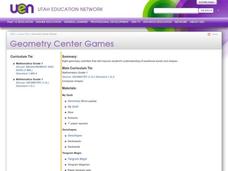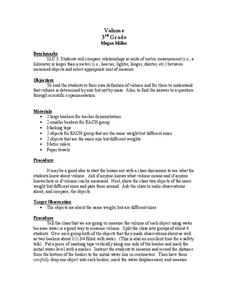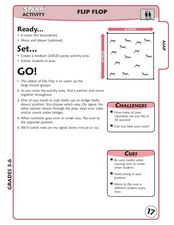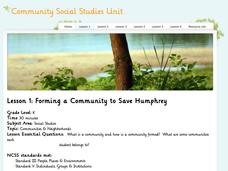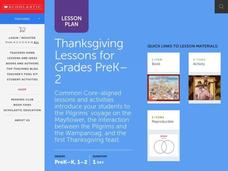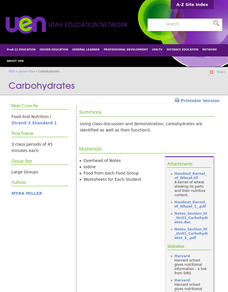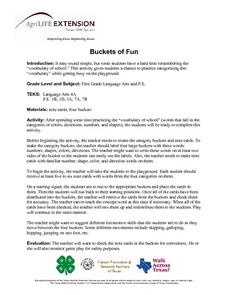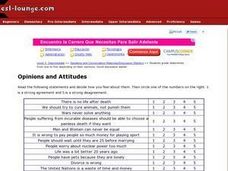Curated OER
Macroinvertebrate Mix and Match
Students are introduced to macroinvertebrates (primarily insects), the major segments of aquatic insects (the head, thorax and abdomen) and also differentiate between larval, nymph and adult stages. They investigate the head, thorax and...
Curated OER
Geometry Center Games
First graders review the placement of positional words and shapes. In groups, they travel between eight centers throughout the classroom in which they participate in various activities. They focus on concepts that are related to Geometry.
Curated OER
Volume
Third graders complete scientific investigation to determine what volume is and how it is determined by size not by mass. They discuss what they know about volume before proceeding with the demonstration and experimentation. After the...
Curated OER
Introduction to Indians and the First Thanksgiving
Students use yarn to create a timeline of the first Thanksgiving. After a class discussion, they view pictures of artifacts and Native Americans to identify the tools and items present during the first Thanksgiving. In groups, they...
Curated OER
Flip Flop
Students participate in a stretching warm-up exercise. In this physical education instructional activity, students warm up the large muscle groups by standing on their hands and legs in a belly up position or a belly down position....
Curated OER
Brain Booster
In this daily math problem worksheet, students complete a hundreds board activity that uses a smiley face format on the board. Students solve the addition and subtraction problems to complete the board.
Community Social Studies Unit
Lesson 1 - Community Social Studies Unit
Some problems are so big it takes an entire community to solve them. So was the case in the children's book Humphrey the Lost Whale: A True Story by Wendy Tokuda and Richard Hall. This primary grade lesson uses a class read-aloud of...
Scholastic
Thanksgiving Lessons Grades PreK-2
A quintessential resource for teaching an elementary unit on the first Thanksgiving addresses a variety of skills, including informational reading, critical thinking, comparing and contrasting facts, technology tools, and historical...
Curated OER
Ordering Numbers to 1,000
In this ordering numbers to one thousand worksheet, students, working with a partner, calculate the answers to eight word problems involving ordering numbers to one thousand.
Curated OER
Greater Than, Less Than, and Equal To
In this comparing numbers worksheet, students read a one page information text about the use of the <, >, or = symbols. Students place the correct symbol in 12 problems.
Curated OER
Bubbly Bs and Dull Ds
Students practice discerning between the letters D and B. Through hands on activities, they recognize the difference between the commonly confused letters B and D. They practice writing both letters and correcting common mistakes and...
Curated OER
Double, Double, Toil and Trouble: A Dual Exploration of Macbeth
Students emulate a key practice of Renaissance theater: doubling. The goal of this lesson is for students to experience-to see, hear, and feel-the differences between characters. Each group presents scenes to the rest of the class.
Curated OER
The Escape
Students find strategies for investigating number problems. They find a common multiple of a group numbers. The teacher introduces the problem and students read and think about it. In groups, students discuss the problem and write...
Curated OER
Place Value Partners
In these place value game worksheets, students pair with a partner and use the game boards to place number tiles on the place value strips that list place values from ones to millions. Students place the tiles and name the digit and...
Curated OER
Buffalo Gone: Appreciating Natural Resources
Students develop numercy skills by studying the number of bison before and after the arrival of European settlers in Canada. They examine the affect of the reduction in the number of bison on Native families.
Curated OER
Interpreting Quotes from Native Americans and European Americans (1790s-1820s)
Students examine the relationships between Native Americans and Europeans. Using the War of 1812, they analyze quotes of each group and discuss how they are connected to the war. They discover how each group viewed the same situation...
Curated OER
Mitosis and Meiosis
Students model and differentiate between the processes of mitosis and meiosis. In partners, they use yarn and construction paper to create models for each of the phases of mitosis and meiosis then compare the chromosome numbers in each...
Curated OER
Adventures With Maps And Globes
First graders examine the differences between a map and a globe. They discuss and identify the symbols on maps and globes, then in small groups complete a worksheet. Students then complete a Venn Diagram comparing maps and globes.
Curated OER
Carbohydrates
Students listen to a lecture on carbohydrates focusing on the differences between complex and simple carbohydrates. They complete a demonstration and worksheet.
Curated OER
Buckets of Fun
First graders practice their "vocabulary of school" by placing their word cards in the appropriate bucket. They may be asked to use a different locomotive skill as they move between the four buckets.
Curated OER
Frame Animation
Students examine the idea that an object might never have a "fixed" existence and may be a thing existing always in flux by creating a frame-based animation of something that transforms from one shape into another. They create...
Curated OER
Spring Awakenings
Learners observe changes in a selected tree bud/leaf during spring. They record changes in the bud/leaf using words, pictures and numbers. They understand that trees adapt to changes in temperature, light, and moisture by sprouting leaves.
Curated OER
Opinions and Attitudes
In this ESL conversation starter worksheet, students read 15 controversial statements. Students circle numbers between 1 and 5 to show degrees of agreement/disagreement. Students talk about the statements. Note: The statements are...
Curated OER
Range and Mode
In this range and mode learning exercise, students read the math word problems and the numbers within the problem to help find the range and mode for each problem.

